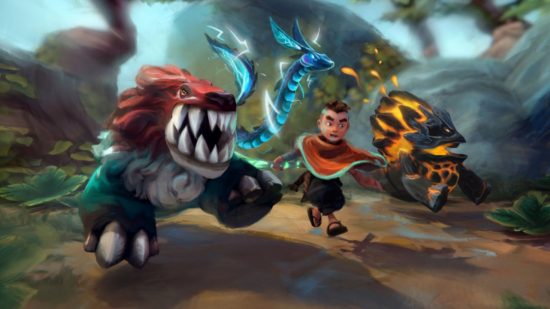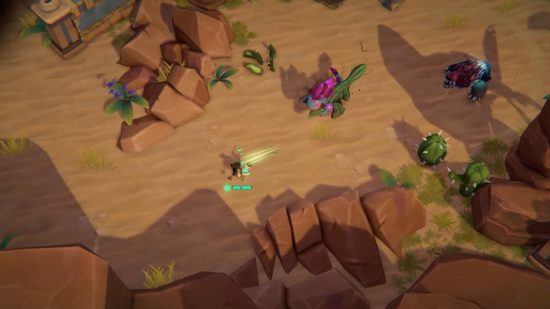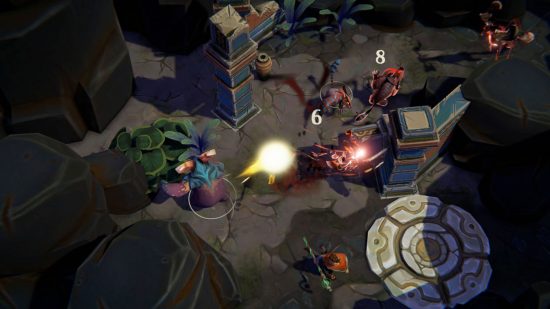Monster-collecting games are all the rage these days. Still, most continue to offer the same formula from 1995, offering us cute critters, RPG mechanics, and relatively tame storytelling. Adore is a slightly different proposition for the sub-genre, blending dungeon-crawling mechanics with monster-taming staples for something with a lot of ambition, even if it doesn’t always come to fruition.
Adore takes place in a mystical fantasy world that lost its gods long ago. As Lukha, an Adorer, you are a follower of the old ways and the old gods. To make that role easier, you inhabit the spirit of Draknar, the fallen god of creatures, and together you set off into various dungeons to collect creatures and restore Draknar’s power. There are serious Avatar: The Last Airbender vibes here, from the world moving away from a great age to the protagonist’s blue facepaint, but it manages to stand apart just enough to not seem derivative.
In terms of gameplay, the best and most concise way to describe Adore is as a Pokémon and Diablo hybrid. You control a party of up to four monsters, who you send out with corresponding battles into wild creatures across various dungeons in the isometric style of Blizzard’s dark dungeon crawler. As the Adorer, you summon your monsters while dodging and dipping out of the way of attacks, adding an element you often don’t think about in other monster-taming titles: your own health.
Of course, catching monsters to add to your roster is a big part of the game, and Adore achieves this in idiosyncratic style, for better or worse. To catch a monster, you need a Particle of Gaterdrik, which are available randomly through different dungeons and also provides some sort of stats boon, like a permanent health or stamina increase. It’s an interesting idea that does change up the formula a touch, but Particles can be tough to pick up, so if you just want to go around catching monsters, trying to find these items consistently can be tricky.

Admittedly, I went into this one pretty skeptical of how it might feel to play. I like a Diablo-esque game as much as the next gamer, but the thought of controlling multiple beasts across the screen seemed slightly overwhelming. It isn’t. In fact, Adore is at its best when there’s a lot going on, with the player character dodging with style across the screen while my ice-boar-wilder-beast thing goes on a rampage. The more beasties you get, the more fun you can have, though a stamina bar stops you from simply rampaging through each level with all four monsters on the prowl.
I do have to take issue with the difficulty curve, which sometimes doesn’t seem to be there at all. I went from one story boss battle right into another, and there is a clear gulf in difficulty between the two, despite the game almost pushing me to take them back to back. The quest-giving is also a little lackluster, sending you in a triangular motion around the sanctuary area to continuously fulfill fetch quests and boss battles for the NPCs you share a homestead with. As I said, the core gameplay is good fun. It’s just the framing that surrounds it that occasionally produces a touch too much tedium.
So, as we really should, let’s talk about the monsters. They’re clearly not intended to be cutesy, but they’re also not edgy in the sense of what you might see in something like Monster Hunter. They’re just a touch bland. The isometric POV doesn’t help much, as you spend most of the time with a top-down viewpoint of the monsters and it offers little character, but even outside of that, few of the creatures who occupy the land of Adorers also occupy my imagination.
This lack of character also extends slightly into the game world. The colors are a touch bland, and the environments feel recycled. There’s just a lack of whimsy, but without all the devils and details of something like Diablo, it also doesn’t feel dark either. All this isn’t to say the game is ugly or the designs are poor. It just lacks a certain pizzazz and charm that monster-taming games ultimately rely on.
Outside of the beasties and the core gameplay, there are lots of ways to influence taking on monsters with your monster synergies, cooking, monster traits, and more. The game does a good job of introducing you to these concepts, with the first couple of gameplay hours acting as a slowly unfolding tutorial. For fans of dungeon-crawling games, this is the usual fare, and it’s easy to engage with the trait system especially. However, for those who are in it for the monster-taming element, it can feel like a lot to manage when you just want to get on with the job of reviving a dead god while getting into a few monster melees.
In terms of how Adore runs on Switch, I had no problems in my game time to report back on, with no memorable instances of frame rate drop. However, I did have to up the brightness from its usual level as this game feels a bit dark in places. Not atmospheric dark, but almost as if a gloomy cloud is covering the world of Adore, blocking the light from coming through. It’s easy to adjust to, but it doesn’t help the case of this game coming across a little bland in places.
Ultimately, Adore is a fine idea that just lacks character. In relying on a unique combination of genre mechanics, it offers something new but forgets to capture – no pun intended – some of the best ideas of both dungeon crawlers and monster-tamers. With more color, exciting monster characters, and a more articulately defined difficulty curve, there could be hope for a future in Adore, but it needs to find itself first.
For more on the latest games, check out our Double Dragon Gaiden: Rise of the Dragons review, Pikmin 4 review, and Hello Kitty Island Adventure review.
Adore review
While the unique monster-taming dungeon-crawling crossover gameplay that occupies much of Adore is surprisingly engaging, a lack of character and a bendy difficulty curve stop it from reaching its potential heights.














